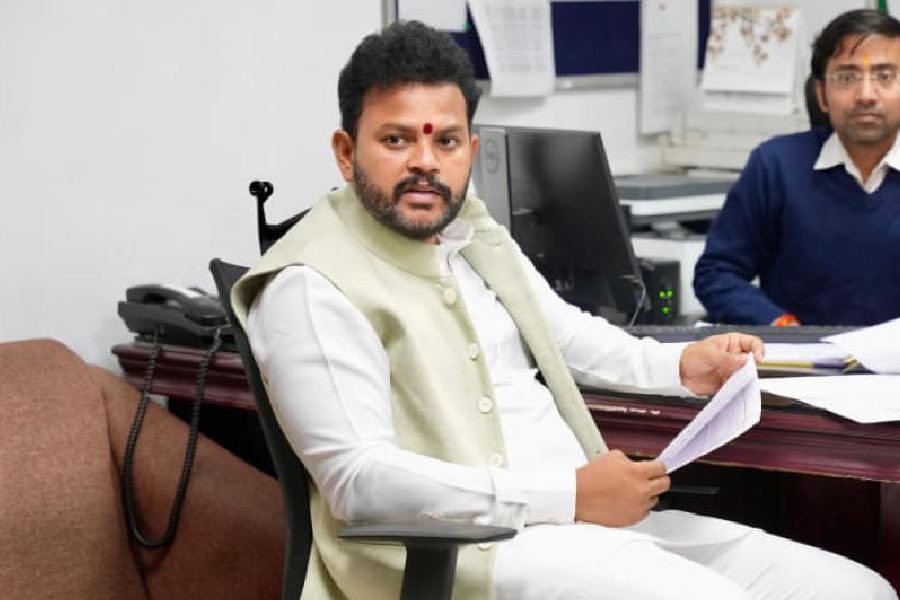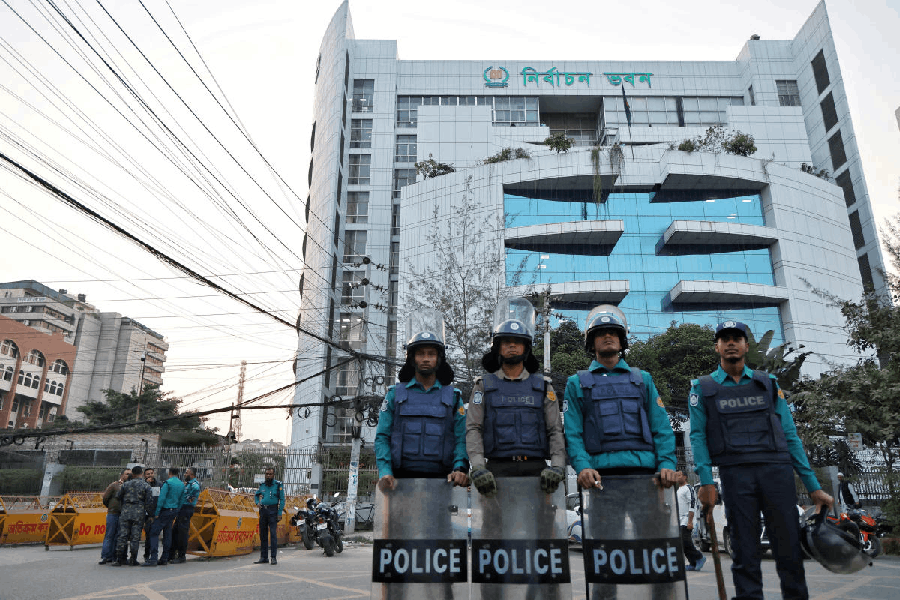 |
In January 1874, the Victorian poet and landscape painter, Edward Lear, arrived in Darjeeling after eight days of harrowing travel from Calcutta, in the course of which his cart had broken down and his coolies had fled. All cares were apparently forgotten at the first glimpse of “Mount Kinchinjunga” (“Wonderful wonderful view”), which, in those days of shifting facts, ranked above Mount Everest in terms of height. By the next day, his enthusiasm had faded — the old cynical self, averse to surprises, was getting back its hold. “Kinchinjunga is not — so it seems to me — a sympathetic mountain; it is so far off, so very god-like and stupendous, & all that great world of dark opal vallies [sic] full of misty, hardly to be imagined forms, — besides the all but impossibility of expressing the whole as a scene — make-up a rather distracting and repelling whole!”
From this outburst, it would seem that Lear, faced with the Burkean Sublime, was fighting the effect his Kinchinjunga was having on him. Yet in the course of the following days, he would look and look again at the mountain at sunrise and sunset, and make it the subject of three large oils (picture) and several watercolours. One of the oils, later sent to Lady Aberdare, had the request: “I hope you will kindly write me a line, when the ‘Kinchinjunga’ arrives at Duffryn, to tell me how you like it. All I beg of you particularly is this, — that if it stands on the ground, you will put up a railing to prevent the children — particularly the twins, from falling over the edge into the Abyss.” So the ‘unsympathetic’ mountain had given him a sense of terror, which he had tried to incorporate in the painting. I pondered all these as I stared at Kanchenjunga floating like a dream on the robin-blue Darjeeling sky. Since I have been in love with this mountain from the first time I saw it some 20 years back, I asked myself how my lofty lover has treated me all these years.
The answer my mind gave me was not heartening. After pulling me back to Darjeeling repeatedly, Kanchenjunga has refused to show itself on most of the trips. I have thumped my feet, gnashed my teeth, made horrid faces at that expanse in the sky where Kanchenjunga is supposed to be, but it has remained hidden, ignoring my entreaties. Even this time, as I stared at Kanchenjunga with lovelorn eyes, it quickly wrapped up its head in a scarf of clouds. Like an image on a magic slate, it would soon wipe itself off, and I would be left with turbulent emotions turning into icicles, which would poke and puncture dreams on fitful nights. Kanchenjunga offers strange knowledge, which I can hardly decode. Always there, whether visible or not, it suggests almost inhuman hope, and stemming from that, courage. But it dares me to sustain these emotions in less salubrious climes and times, when even the possibility of Kanchenjunga’s presence won’t be there in the sky. With the height comes the abyss.
Kanchenjunga must be doing this to poor mortals for ages. All the characters in Satyajit Ray’s film named after the mountain have their individual moments of being, in which certain certainties dissolve as the light shifts with the drifting mist. When the magic mountain appears in the last shot, one feels that it had been stage-managing the chiaroscuro effect from the very start, when the characters had set out in different directions from the Mall. But after that dazzling final shot of Kanchenjunga, comes the fade-out, accompanied by the lilting tune of the song sung by the beggar boy, who is the ally of the mountain in the film. As the music dies with a dying fall, one wonders whether the characters will be able to sustain that moment of revelation. After all, certainties, like those offered to Monisha by her stolid (rejected) suitor, Banerjee, are tempting in the security they promise. The poor graduate in Bengali literature, Ashok, the other contestant for Monisha’s hand, has also shown much promise in defying Monisha’s father, the formidable Raibahadur Indranath Chowdhury, but he has not held out security.
Sitting on the terrace of Darjeeling’s Windamere Hotel, where Ray had written the script of the film in 1961, I thought of Kanchenjunga, Kanchenjunga, and Father Time (the bells of the Mahakal temple chimed in the adjacent hill). Everything merged, like the layers in a palimpsest. Indranath Chowdhury, the pater familias in Kanchenjunga, is a relic of the Raj, as the hotel is, and, indeed, the Chowdhury family was staying at Windamere in the movie. Taking in the high-ceilinged rooms, the chintz curtains, the parlour, the perfectly ordered garden, or the music room of the hotel, I could understand why Chowdhury, the ardent worshipper of everything British, had made Windamere his home in Darjeeling.
To my mongrel spirit, it was a pretty, porcelain world of make-believe in which the ghosts of homesick planters still grow bleary eyed over that “corner of a foreign field/ That is for ever England” — whisky-soda in hand and “Auld lang syne” in head. Like all illusions, this place also exuded comfort, which, if nothing, was immensely alluring. Tucking myself in under the snow-white blankets and watching the blue elves of fire dance in the grate, my mind wandered back to Ray’s Monisha. If she continues following her will against that of her father when she goes back to Calcutta, and marries the penniless Ashok, she will probably have to give up on places like Windamere. Will she then miss such luxuries and repent her Kanchenjunga-inspired defiance?
Finding no solution to Monisha’s imagined dilemma, I roamed about in the hotel’s quaintly named Bearpark’s Parlour leading to Daisy’s Music Room, both of which constitute quite a gallery, given the series of old photographs on the walls. All this while, I was growing increasingly jaunty at the effort not to disturb English delicacy, apparent in such instructions as the one on the mantelpiece asking visitors “not to take off their footwear, or put up their feet on the furniture, or lie supine on the hearth, or sleep behind the settees, lest unintended offence be given to others”. Almost standing on tiptoe, I looked up the framed pictures and letters. There was King George VI, Queen Elizabeth, Nehru at the Independence Day parade, a letter from Alexandra David-Néel, the French lady who had dressed up as a man to get into forbidden Tibet, among others (the latter had stayed at the hotel and has a suite named after her).
And then, suddenly, there was Rabindranath Tagore writing to Sardar Bahadur S.W. Laden La (the famous police officer of Darjeeling, a favourite of the British ) in November 1931. The poet excuses himself from a trip planned to a monastery, saying that he is “too tired and weak” to undertake it. I felt weirdly elated at Tagore’s peevishness, perhaps because his seemed to be the only voice in the gallery that was not laudatory. Chuckling to myself in the silence of the hall, I became conscious of a sinister ticking in the background. It was the huge wall clock, telling me that time was trickling out slowly and steadily, and very soon I will have to leave while Kanchenjunga will keep on standing undisturbed. The icicles in the heart glinted like knives.
Scampering outside, I found myself in front of the ivy-draped room called “A Room called Alice”. Perhaps on the other side of its pint-sized closed doors, a tea party was on, with treacle flying in the air, milk jugs being upset on plates and the Dormouse being stuffed into the teapot. In the Mad Hatter’s memory, the Queen of Hearts was screaming, “He’s murdering the time! Off with his head!”, at which the clock stopped at six o’clock, forever, burying the burnt-out ends of smoky days.
I decided that Monisha would not miss much if she has to leave behind Windamere and all that it represents. The past — like the one preserved in the hotel — is an illusion, and the future — yawning like a black hole in Calcutta — is a fantasy. In between there was the present— glistening, dissolving, real — like golden Kanchenjunga pasted on a violet sky.










